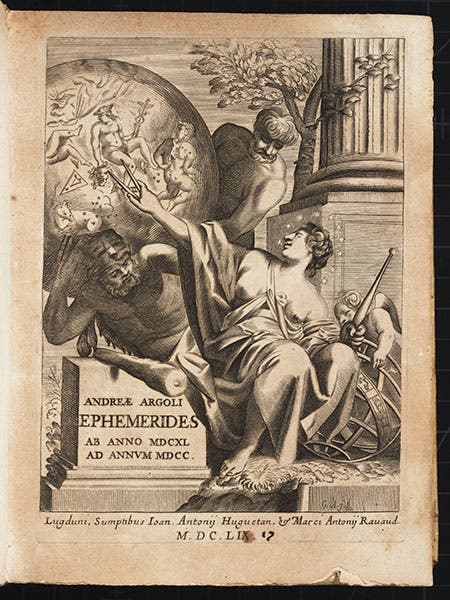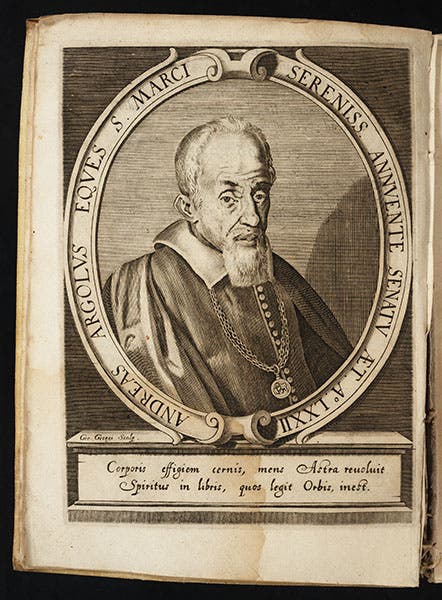Scientist of the Day - Andrea Argoli
Andrea Argoli, an Italian astronomer, was born Mar. 15, 1570 (or perhaps 1568). All of the available biographies pretty much agree on the skimpy details of Argoli's life - he was an avid astrologer, teaching at the Sapienza in Rome until 1627, when he ran afoul of the new Pope, Urban VIII, who had a thing about astrologers who cast less than rosy horoscopes. So Argoli wisely moved to Padua, where he taught for the rest of his life. Most of his publications were ephemerides, sets of tables that forecast planetary positions for the next 10 or 20 years; these were regularly updated and reissued.
We have four books by Argoli in our collection, all ephemerides, and since we cannot add anything to the meager store of facts about Argoli's life, we thought we would use the occasion to illustrate and discuss the engraved title pages that grace three of his books in our collection. Many 17th-century scientific books had illustrated title pages, but it was unusual for a single author to issue books with a variety of title pages, especially if each of the books was essentially the same book, revamped, as was the case with Argoli. Perhaps this was a way to disguise that fact. The title-page engraving of his Ephemerides of 1638 (second image) shows Atlas and Hercules at the flanks, a good choice for an astronomy book, since Atlas held the heavens on his shoulders and Hercules obliged when Atlas asked if he would take over for a while. The only problem is that the Atlas/Hercles motif was borrowed blatantly from the engraved title page of Johan Bayer's Uranometria (1603), which you can see here. Argoli had first used Bayer’s layout on a set of tables published in 1610 (which we do not own); he wasn’t too ashamed to borrow it again, although this time around, he added portraits at the top of himself and Tycho Brahe, on whose work the tables were based.
The Primi mobilis tabulae (1644) had an engraved title page that was more original (third image). It is not only astronomical, with Pegasus, Scorpio, Libra, Virgo, and various instruments on display, it is also pedagogical, with the terms “Phaenomena,” “Ratio” and “Observationes” prominently placed, as well as “Geometria” and “Arithmetica”. If there is a message here about the relationship between reason, observations, and phenomena, it escapes us. But there is no denying that this is a dramatic title page, with Pegasus flying off into the heavens, much more so than the standard architectural title page that appeared in his earlier work. We opened with a detail of this engraving, featuring Pegasus (first image).
Finally, the Ephemerides of 1659 (fourth image) opens with an engraving portraying what appears to be the Farnese Atlas. This is an ancient Roman copy of a Greek statue and features the oldest known star-globe in the west. The statue was acquired by the Farnese family and was on display in Argoli’s time at the Villa Farnese, northwest of Rome. But if we look closely, we see that this is not Atlas holding the globe, but rather Hercules, as is evident by the lion-skin hood and the club. We have here a very clever variation on the 1638 title page, with Atlas and Hercules exchanging roles, except this time the conception is quite original. We might even call Argoli’s version the Farnese Hercules. Except there already was a Farnese Hercules, this one at the Palazzo Farnese in Rome, and it did not come with a globe.
So it seems we have really used Argoli as an excuse to show off some lesser-known illustrated title pages. That is not such a bad thing. The engraved portrait of Argoli appears in several of his volumes; we show the one from the Primi mobilis tabulae (fifth image).
Dr. William B. Ashworth, Jr., Consultant for the History of Science, Linda Hall Library and Associate Professor, Department of History, University of Missouri-Kansas City. Comments or corrections are welcome; please direct to ashworthw@umkc.edu.








![Using an astrolabe to measure the depth of a well, woodcut in Elucidatio fabricae vsusq[ue] astrolabii, by Johannes Stöffler, 1513 (Linda Hall Library)](https://assets-us-01.kc-usercontent.com:443/9dd25524-761a-000d-d79f-86a5086d4774/a998eb50-55d2-4a88-ace2-a50aa5fa86e7/Stoffler%201.jpg?w=210&h=210&auto=format&fit=crop)

